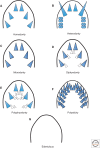Indeterminate Growth: Could It Represent the Ancestral Condition?
- PMID: 26216720
- PMCID: PMC4743077
- DOI: 10.1101/cshperspect.a019174
Indeterminate Growth: Could It Represent the Ancestral Condition?
Abstract
Although we are used to the idea that many organisms stop growing when they reach a predictable size, in many taxa, growth occurs throughout the life of an organism, a phenomenon referred to as indeterminate growth. Our comparative analysis suggests that indeterminate growth may indeed represent the ancestral condition, whereas the permanent arrest of growth may be a more derived state. Consistent with this idea, in diverse taxa, the basal branches show indeterminate growth, whereas more derived branches arrest their growth. Importantly, in some closely related taxa, the termination of growth has evolved in mechanistically distinct ways. Also, even within a single organism, different organs can differ with respect to whether they terminate their growth or not. Finally, the study of tooth development indicates that, even at the level of a single tissue, multiple determinate patterns of growth can evolve from an ancestral one that is indeterminate.
Copyright © 2016 Cold Spring Harbor Laboratory Press; all rights reserved.
Figures



References
-
- Abeloos M. 1930. Recherches expérimentales sur la croissance et la régénération chez les Planaires [Experimental research on development and regeneration in planarians]. Bull Biol France Belg 64: 1–140.
-
- Alberch P. 1980. Ontogenesis and morphological diversification. Am Zool 20: 653–667.
-
- Alberch P, Gould SJ, Oster GF, Wake DB. 1979. Size and shape in ontogeny and phylogeny. Paleobiology 5: 296–317.
-
- Baguña J. 1998. Planarians. In Cellular and molecular basis of regeneration (ed. Ferretti P, Géraudie J), pp. 135–165. Wiley, Chichester, UK.
Publication types
MeSH terms
LinkOut - more resources
Full Text Sources
Other Literature Sources
